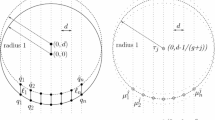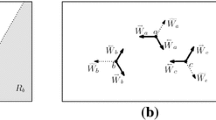Abstract
The SINR model for the quality of wireless connections has been the subject of extensive recent study. It attempts to predict whether a particular transmitter is heard at a specific location, in a setting consisting of n simultaneous transmitters and background noise. The SINR model gives rise to a natural geometric object, the SINR diagram, which partitions the space into n regions where each of the transmitters can be heard and the remaining space where no transmitter can be heard.
Efficient point location in the SINR diagram, i.e., being able to build a data structure that facilitates determining, for a query point, whether any transmitter is heard there, and if so, which one, has been recently investigated in several papers. These planar data structures are constructed in time at least quadratic in n and support logarithmic-time approximate queries. Moreover, the performance of some of the proposed structures depends strongly not only on the number n of transmitters and on the approximation parameter \(\varepsilon \), but also on some geometric parameters that cannot be bounded a priori as a function of n or \(\varepsilon \).
In this paper, we address the question of batched point location queries, i.e., answering many queries simultaneously. Specifically, in one dimension, we can answer n queries exactly in amortized polylogarithmic time per query, while in the plane we can do it approximately.
All these results can handle arbitrary power assignments to the transmitters. Moreover, the amortized query time in these results depends only on n and \(\varepsilon \).
Finally, these results demonstrate the (so far underutilized) power of combining algebraic tools with those of computational geometry and other fields.
Work on this paper by B.A. has been partially supported by NSF Grants CCF-11-17336 and CCF-12-18791. Work on this paper by M.K. has been partially supported by grant 1045/10 from the Israel Science Foundation. A more complete version of this paper is available on arXiv [3].
Access this chapter
Tax calculation will be finalised at checkout
Purchases are for personal use only
Preview
Unable to display preview. Download preview PDF.
Similar content being viewed by others
References
Ajwani, D., Ray, S., Seidel, R., Tiwary, H.R.: On computing the centroid of the vertices of an arrangement and related problems. In: Dehne, F., Sack, J.-R., Zeh, N. (eds.) WADS 2007. LNCS, vol. 4619, pp. 519–528. Springer, Heidelberg (2007)
Andrews, M., Dinitz, M.: Maximizing capacity in arbitrary wireless networks in the SINR model: Complexity and game theory. In: INFOCOM, pp. 1332–1340 (2009)
Aronov, B., Katz, M.J.: Batched point location in SINR diagrams via algebraic tools (2014). arXiv:1412.0962 [cs.CG]
Aurenhammer, F., Edelsbrunner, H.: An optimal algorithm for constructing the weighted Voronoi diagram in the plane. Pattern Recognition 251–257 (1984)
Avin, C., Cohen, A., Haddad, Y., Kantor, E., Lotker, Z., Parter, M., Peleg, D.: SINR diagram with interference cancellation. In: SODA, pp. 502–515 (2012)
Avin, C., Emek, Y., Kantor, E., Lotker, Z., Peleg, D., Roditty, L.: SINR diagrams: Convexity and its applications in wireless networks. J. ACM 59(4), 18:1–318:4 (2012)
Bini, D., Pan, V.Y.: Polynomial and Matrix Computations: Fundamental Algorithms, vol. 1. Birkhauser Verlag, Basel (1994)
de Berg, M., Cheong, O., van Kreveld, M., Overmars, M.H.: Computational Geometry: Algorithms and Applications, 3rd edn. Springer-Verlag, Berlin (2008)
Goussevskaia, O., Halldórsson, M.M., Wattenhofer, R., Welzl, E.: Capacity of arbitrary wireless networks. In: INFOCOM, pp. 1872–1880 (2009)
Goussevskaia, O., Oswald, Y.A., Wattenhofer, R.: Complexity in geometric SINR. In: MobiHoc, pp. 100–109 (2007)
Gupta, P., Kumar, P.R.: The capacity of wireless networks. IEEE Trans. Information Theory 46(2), 388–404 (2000)
Halldórsson, M.M.: Wireless scheduling with power control. ACM Transactions on Algorithms 9(1) (2012)
Halldórsson, M.M., Mitra, P.: Wireless capacity with oblivious power in general metrics. In: SODA, pp. 1538–1548 (2011)
Halldórsson, M.M., Wattenhofer, R.: Wireless communication is in APX. In: Albers, S., Marchetti-Spaccamela, A., Matias, Y., Nikoletseas, S., Thomas, W. (eds.) ICALP 2009, Part I. LNCS, vol. 5555, pp. 525–536. Springer, Heidelberg (2009)
Har-Peled, S., Kumar, N.: Approximating minimization diagrams and generalized proximity search. SIAM J. Comput. Accepted for publication. http://sarielhp.org/p/12/wann/wann.pdf
Har-Peled, S., Kumar, N.: Approximating minimization diagrams and generalized proximity search. In: FOCS, pp. 717–726 (2013)
Kantor, E., Lotker, Z., Parter, M., Peleg, D.: The topology of wireless communication. In: STOC, pp. 383–392 (2011)
Kesselheim, T.: A constant-factor approximation for wireless capacity maximization with power control in the SINR model. In: SODA, pp. 1549–1559 (2011)
Lotker, Z., Peleg, D.: Structure and algorithms in the SINR wireless model. SIGACT News 41(2), 74–84 (2010)
Moroz, G., Aronov, B.: Computing the distance between piecewise-linear bivariate functions. In: SODA, pp. 288–293 (2012)
Moroz, G., Aronov, B.: Computing the distance between piecewise-linear bivariate functions. ACM Transactions on Algorithms (2013). Accepted for publication arXiv:1107.2312 [cs.CG]
Moscibroda, T., Wattenhofer, R.: The complexity of connectivity in wireless networks. In: INFOCOM, pp. 23–29 (2006)
von zur Gathen, J.: Modern Computer Algebra. Cambridge University Press, Cambridge (1999)
Wan, P.-J., Jia, X., Yao, F.: Maximum independent set of links under physical interference model. In: Liu, B., Bestavros, A., Du, D.-Z., Wang, J. (eds.) WASA 2009. LNCS, vol. 5682, pp. 169–178. Springer, Heidelberg (2009)
Author information
Authors and Affiliations
Corresponding author
Editor information
Editors and Affiliations
Rights and permissions
Copyright information
© 2015 Springer-Verlag Berlin Heidelberg
About this paper
Cite this paper
Aronov, B., Katz, M.J. (2015). Batched Point Location in SINR Diagrams via Algebraic Tools. In: Halldórsson, M., Iwama, K., Kobayashi, N., Speckmann, B. (eds) Automata, Languages, and Programming. ICALP 2015. Lecture Notes in Computer Science(), vol 9134. Springer, Berlin, Heidelberg. https://doi.org/10.1007/978-3-662-47672-7_6
Download citation
DOI: https://doi.org/10.1007/978-3-662-47672-7_6
Published:
Publisher Name: Springer, Berlin, Heidelberg
Print ISBN: 978-3-662-47671-0
Online ISBN: 978-3-662-47672-7
eBook Packages: Computer ScienceComputer Science (R0)




